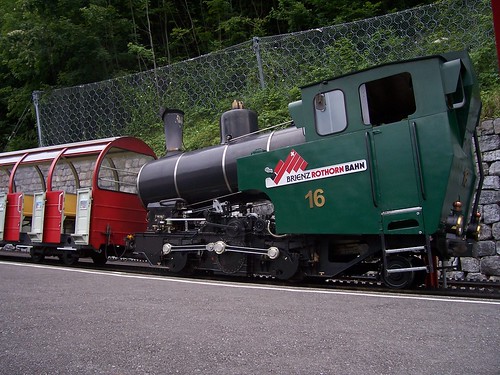The development of the steam locomotive did not end in the 1950s. For one reason and another, a few countries kept their steam locomotives going. One of these was Argentina, where a coal-carrying railway purchased a new fleet as recently as 1973. In South Africa, subject to sanctions, a study in the late 1980s actually showed that in the special conditions that prevailed, with cheap labour, plentiful coal, and an oil embargo, it would be cheaper to continue to use steam traction on routes that were not worth electrifying. Ignoring this conclusion, the railway administration replaced its steam fleet with diesels anyway!
In a remote area of Argentina, a series of experiments was conducted by an idiosyncratic engineer, L D Porta. The most important of these (the locomotives were burning coal) was to introduce waste steam into the fire. This causes the so-called water gas reaction, in which water and carbon produce hydrogen and carbon monoxide gas, which then burn in the usual way, though completely and without black smoke. Because this reaction is endothermic, the fire is cooled, which prevents ash from melting, blocking the firebed and having to be dug out laboriously by hand. Porta also improved the design of the exhaust system, to make it more efficient and reduce spark-throwing. In one final fling of innovation, these features were successfully applied to a single locomotive on the South African Railways. Efficiency was, it was claimed, increased by almost one-third.
Not the end of the story
That was not quite the end of the story either. Steam continues to be used on tourist and museum railways. In some cases it is hopelessly inefficient and the cost of the coal is a matter of concern. In the early 1990s, a batch of new steam locomotives were constructed for tourist railways in Austria and Switzerland (photograph above). These simply burn diesel oil, which sounds wasteful, given the inherently lower thermal efficiency of the steam locomotive. The operators then found the the steam locomotives were using less fuel then their diesel locomotives, which was unexpected and not what was meant to happen. Presumably they simply realised that they were putting less in the fuel tanks. The manufacturers carried out an audit and discovered the explanation. There were three reasons for the lower fuel consumption: the diesels wasted a lot of fuel when the engines were left idling whilst stationary and running downhill, the diesels had to provide additional power to brake the trains and there was less energy lost from direct drive of the steam locomotives. It was no mystery, but it goes to show that theory and practice are two different things.
Following this successful experience, there is a tentative proposal to use modern steam locomotives of a new, though essentially conventional design, in other special situations where similar benefits might be achieved. These modern steam locomotives do not come particularly cheap, especially since the price of diesel-electric locomotives is relatively lower, but given a reasonable production run, the manufacturer believes that he can still offer two or more for the price of one diesel. For railways that are never going to be electrified, this sounds like an option worth considering.
In a remote area of Argentina, a series of experiments was conducted by an idiosyncratic engineer, L D Porta. The most important of these (the locomotives were burning coal) was to introduce waste steam into the fire. This causes the so-called water gas reaction, in which water and carbon produce hydrogen and carbon monoxide gas, which then burn in the usual way, though completely and without black smoke. Because this reaction is endothermic, the fire is cooled, which prevents ash from melting, blocking the firebed and having to be dug out laboriously by hand. Porta also improved the design of the exhaust system, to make it more efficient and reduce spark-throwing. In one final fling of innovation, these features were successfully applied to a single locomotive on the South African Railways. Efficiency was, it was claimed, increased by almost one-third.
Not the end of the story
That was not quite the end of the story either. Steam continues to be used on tourist and museum railways. In some cases it is hopelessly inefficient and the cost of the coal is a matter of concern. In the early 1990s, a batch of new steam locomotives were constructed for tourist railways in Austria and Switzerland (photograph above). These simply burn diesel oil, which sounds wasteful, given the inherently lower thermal efficiency of the steam locomotive. The operators then found the the steam locomotives were using less fuel then their diesel locomotives, which was unexpected and not what was meant to happen. Presumably they simply realised that they were putting less in the fuel tanks. The manufacturers carried out an audit and discovered the explanation. There were three reasons for the lower fuel consumption: the diesels wasted a lot of fuel when the engines were left idling whilst stationary and running downhill, the diesels had to provide additional power to brake the trains and there was less energy lost from direct drive of the steam locomotives. It was no mystery, but it goes to show that theory and practice are two different things.
Following this successful experience, there is a tentative proposal to use modern steam locomotives of a new, though essentially conventional design, in other special situations where similar benefits might be achieved. These modern steam locomotives do not come particularly cheap, especially since the price of diesel-electric locomotives is relatively lower, but given a reasonable production run, the manufacturer believes that he can still offer two or more for the price of one diesel. For railways that are never going to be electrified, this sounds like an option worth considering.

Kommentarer